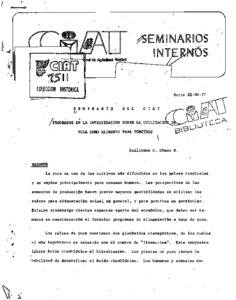Progresos en la investigacion sobre la utilizacion de yuca como alimento para porcinos
The use of cassava-based feedstuffs seems promising, especially for swine; however, toxic factors must be taken into account when diets are formulated. In Africa, cassava consumption is indicated as one of the factors responsible for the tropical ataxic neuropathy syndrome observed in Nigeria: it is also reported causing goiter in areas where I-deficient diets predominate (Nigeria and Zaire). A hypothetical model of the cassava goiter- causing mechanism has been formulated. Most of the information on the utilization of cassava in swine feeding has been produced by CIAT and the Instituto Colombiano Agropecuario (Colombia). An increase of 65-70 percent in protein supplement is required in cassava-based feeds, as compared to cereals, because of its low protein content. The Swine Protection Unit and the Cassava Program at CIAT, together with the University of Guelph (Canada), are cooperating on a project to produce microbial protein, using cassava roots as the substrate for the fungus Aspergillus fumigatus I-21A, an asporogenous mutant that grows under very limited temperature (45 degrees Celsius) and pH (3.5) conditions.Currently, another mutant (A. fumigatus ON5), sensitive to temperatures of 37-40 degrees Celsius, is being tested; its spores are not able to grow at animal body temperatures. Results to date suggest good potential perspectives. (AS)

